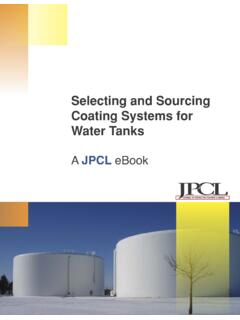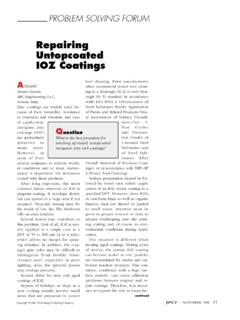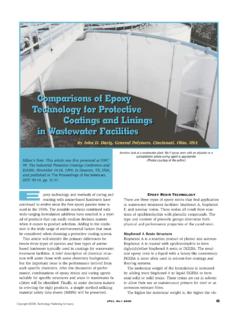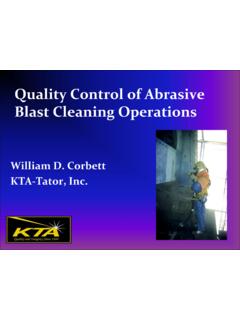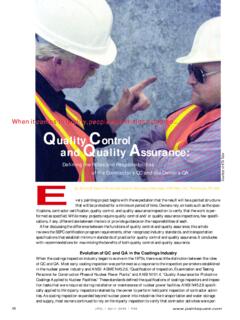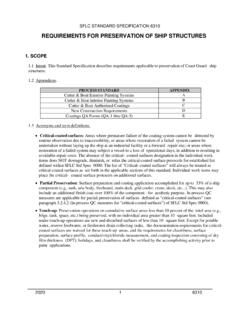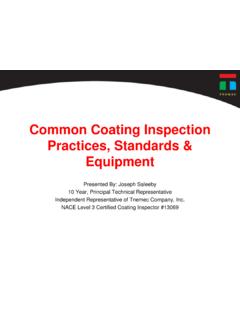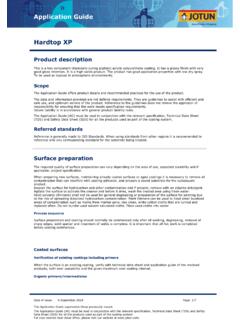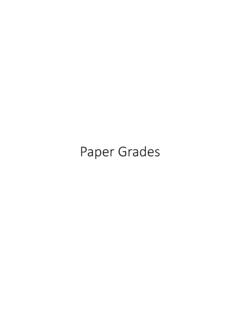Transcription of SSPC-PA 2 Procedure for Determining Conformance to Dry ...
1 SSPC-PA 2 procedure for determining conformance to dry coating thickness Requirements William D. Corbett, KTA-Tator, Inc. Chair SSPC Committee on Dry Film thickness measurement SSPC-PA 2 procedure for determining conformance to dry coating thickness Requirements Webinar Content Background of SSPC PA 2 Overview and Purpose of SSPC-PA 2 (2012) Purpose of ASTM D 7091-12 Definitions Gage Descriptions Calibration, Verification of Accuracy & Adjustment measurement procedures Frequency and Number of Measurements Conformance to Specified thickness Content of Eight Appendices Learning Objectives/Outcomes Completion of this webinar will enable the participant to.
2 Describe the purpose and content of SSPC-PA 2 Describe the differences between Type 1 and Type 2 gages Describe the processes associated with calibration, verification of accuracy and adjustment Explain Base Metal Reading acquisition Describe the frequency and tolerance of measurements Describe the Procedure for Determining the magnitude of a non-conforming area Describe the basic content of eight appendices to the standard Background of SSPC-PA 2 Originally published in SSPC Volume 2 in 1973(T) Most recent update was 2004 Editorial revision to an Appendix in 2009 SSPC committee work on revisions initiated in 2007 Current version dated May 1, 2012 Standard re-balloted in August/September 2013 Background of SSPC-PA 2 Update to ASTM D 7091-05 concurrent with revisions to SSPC-PA 2 ASTM D7091-12 focuses on gage use SSPC-PA 2 (2012)
3 Focuses on acceptability of acquired measurements Both address ferrous and non-ferrous metal surfaces Scope of SSPC-PA 2 Describes a Procedure for Determining shop/field Conformance to a specified DFT range on ferrous and non-ferrous metals Measurements are acquired using commercially available gages (two types ) procedures for gage calibration, verification of accuracy and adjustment are described Procedure for Determining Conformance to specified thickness range over extended areas is described Scope of SSPC-PA 2 Standard contains 8 non-mandatory appendices (described later) 9th appendix was recently balloted (precautions regarding the use of the standard for coating failure investigations) Standard is not intended to be used for measurement of thermal spray coatings ( Procedure described in SSPC-CS ) Definitions in SSPC-PA 2 Gage Reading: A single instrument reading Spot measurement : The average of three or at least three gage readings made within a 1 (4 cm) diameter circle Area measurement .
4 The average of five spot measurements over each 100 square feet of coated surface Gage Descriptions Gage type is determined by magnetic properties employed to measure thickness (not the read-out mode) Type 1 Magnetic Pull-off Gages Type 2 Electronic Gages Gage Types Type 1 Magnetic Pull-off Gages Type 2 Electronic Gages Gage Types, continued Type 1 Magnetic Pull-off Gages Permanent magnet contacts coated surface Force required to detach magnet is measured Force interpreted as the coating thickness on scale or display Scale is nonlinear Gage Types, continued Type 2 Electronic Gages Electronic circuitry converts reference signal to coating thickness Calibration & Verification of Accuracy ASTM D7091 describes 3 operational steps to ensure accurate measurement .
5 Calibration Verification of Accuracy Adjustment Steps are required to be completed before coating thickness data acquisition to determine Conformance to a specification Gage Calibration Performed by the gage manufacturer or an accredited calibration laboratory Test certificate traceable to a National Metrology institution required No standard calibration interval (established based on experience & work environment) One year interval is common Verification of Type 1 Gage Accuracy Performed as described in ASTM D7091 Beginning and end of each work shift (minimum) During ( , hourly), if: Obtaining a large no. of readings Gage is dropped or readings are suspect Record: Serial no.
6 Of gage & standard Stated & measured thickness Method used to verify accuracy Verification of Type 1 Gage Accuracy Type 1 gages should not be adjusted Adjustments to the helical spring may void the gage warranty Combined tolerance of gage and coated standard determines gage accuracy , if gage accuracy is 5% and reference standard accuracy is 3%, combined tolerance is ~ 6%, calculated as: 52 + 32 On a 10 mil reference standard, the gage reading can range from mils Correction for Surface Roughness Base Metal Reading (BMR) Effect of surface roughness on coating thickness gage NOT surface profile Measure the prepared, uncoated substrate.
7 Calculate average BMR Deduct BMR from measured coating thickness BMR Correction for Surface Roughness Area BMR 1 30 m ( mils) 2 25 m ( mils) 3 18 m ( mil) 4 13 m ( mil) 5 20 m ( mil) 6 8 m ( mil) 7 25 m ( mil) 8 28 m ( mils) 9 23 m ( mil) 10 13 m ( mil) Measuring Base Metal Effect with Type 1 DFT Gage Average BMR: 21 m ( mil) BMR Correction for Multiple Coat Systems Measured Primer thickness : 102 m ( mils) BMR: 13 m ( mils) Actual Primer thickness : 89 m ( mils) Measured Primer + Finish thickness : 178 m ( mils) BMR: 13 m ( mils) Actual Total System thickness : 165 m ( mils) Correction for Surface Roughness What if access to blast cleaned steel is not available (already coated)?
8 Appendix addresses smooth surface adjustment Verify gage accuracy on a smooth surface (per gage manufacturer instructions) Deduct assumed approximate correction value from each gage reading Correction for Surface Roughness Table A8 Typical Gage Correction Values Using ISO 8503 Profile Grades ISO 8503 Profile Grade Correction Value ( m) Correction value (mils) Fine 10 Medium 25 Coarse 40 Verification of Type 2 Gage Accuracy Verify accuracy per manufacturer instructions (use coated standards) Performed as described in ASTM D7091 Beginning and end of each work shift (minimum) During ( , hourly), if: Obtaining a large no. of readings Gage is dropped or readings are suspect Record: Serial no.
9 Of gage & standard Stated & measured thickness Verification of Type 2 Gage Accuracy Single Point Verification Select one reference coated standard representing the mid-range of the anticipated coating thickness , 4-6 mils (100-150 m), select 5 mil (125 m) reference standard Tw0 Point Verification Select reference coated standards below and above the median anticipated coating thickness , 5 mils (125 m), select 3 mil (75 m) and 7 mil (175 m) coated standards Adjustment of Type 2 Gages Aligning a gage s thickness readings to those of a known thickness value to improve gage accuracy on a specific surface or within a measuring range Corrects for: Surface Roughness Substrate Properties (metallurgy) Curvature Etc.
10 Use Certified or Measured shims Adjustment of Type 2 Gages Addressed in Appendix 8 Follow the gage manufacturers step-by-step procedures for gage adjustment Instructions vary by gage manufacturer Adjustment is performed using certified or measured plastic shims (foils) measurement Frequency measurement Frequency For areas of coating not exceeding 300 square feet, (~30 square meters) each 100 square feet (~10 square meters) is measured For areas of coating exceeding 300 square feet and not exceeding 1000 square feet, arbitrarily select 3 random 100 square foot (~10 square meter) areas and measure measurement Frequency For areas of coating exceeding 1000 square feet (~100 square meters), arbitrarily select 3 - 100 square feet (~10 square meter) areas for the first 1000 square feet (~100 square meters), and 1 additional 100 square foot(~10 square meter) area for each additional 1000 square feet (100 square meters), or portion thereof measurement Frequency Size of Coated Area: 900 square feet No.



